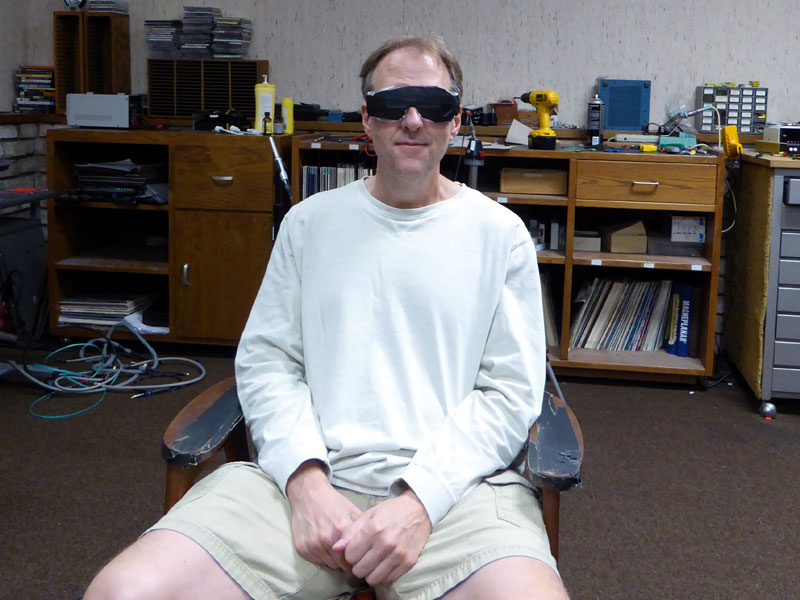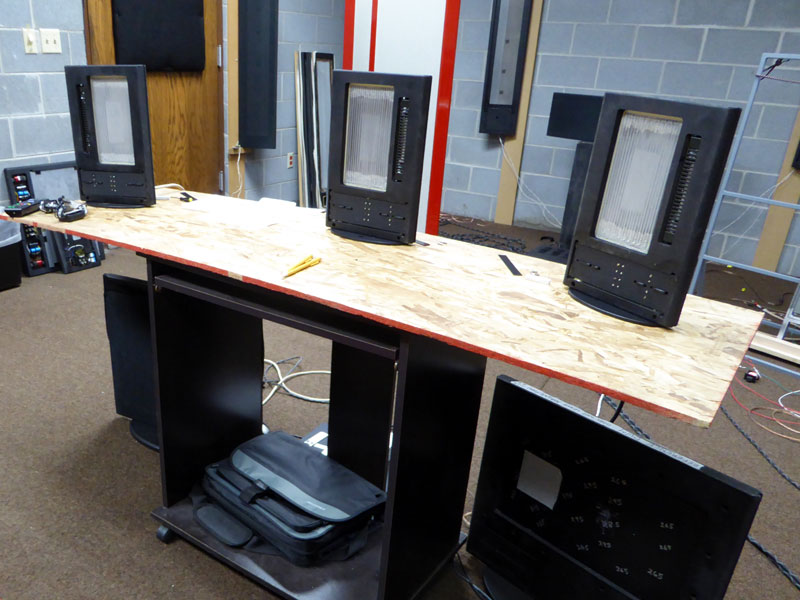Flying Blind: Another Visit to the Magnepan Skunkworks
"Goggles? Why?" I asked Wendell this time, remembering the utter darkness of Magnepan's windowless bunker. "You'll see," he replied. I couldn't see anything.
I decided to go with the flow. Wendell led me to my seat, and I asked him to take the picture you see above. I wasn't convinced I'd use it, thinking that whatever I was going to hear would be a replay of other systems I've heard while sitting in this same seat, so there wouldn't be a new story to tell. I didn't tell Wendell all of this, but I thought that he had finally reached the point of no returns, when the monster doesn't come to life, as happens to some mad scientists. So there I sat in darkness -- in double darkness, in fact, because of the goggles. After a pause, the music began, big, pure and identifiably Magnepan. Wendell played a couple of demo cuts he had played for me before, and then he played some music I'd never heard: orchestra and a pair of vocalists recorded in a church. The recording quality was stunning -- more natural and powerfully real than I've ever heard while at Magnepan. I asked Wendell about the recording, and he told me that it was the work of a little-known professional sound engineer from Washington, DC, Marco Sabatini. He was an admirer of Magnepan speakers and had contacted the company, eventually offering some of his recordings for demonstration purposes. I should say so! This cut, of primarily vocal music, had a massive sense of space, and the placement of the voices was so precise that, while I couldn't see a thing, I felt like I was watching the performers in front of me. As often as I've heard music in this room, in the dark, this might have been the best sound ever. At the very least, it raised the issue. Of course, the question in my mind was, What am I hearing? In the past, I had heard mostly Wendell's pet project: the three-channel stereo configuration, which used a Bryston processor, right and left speakers and a center-channel speaker -- one of various models -- to create a stereo soundstage that was both massive and fully composed no matter where I was sitting. At first, I suspected that the same system was in use here, but then the goggles began to vex me. Why the extreme secrecy? Wendell must be giving me an audition of a new speaker, maybe Magnepan's new top of the line. Was it a 30.7? A new version of the Tympani? My mind ran wild, fueled by the extraordinary sound I was hearing. And "extraordinary" was an accurate way to describe it. In the past, once the lights came on, all was revealed. But this time, after the lights came on and I removed the goggles, I had to acclimate to the light, like a miner coming up from the bowels of the earth. Even more disorienting, after my eyes had adjusted, was what I saw a few feet in front of me.
You see it just as I did: three Mini Maggie speakers along with a pair of DWM woofers ($2600 total) set up as they would be for a very high-quality desktop system. The Magnepan/Bryston SP3 processor ($9800) along with a Bryston multichannel amp and an Oppo Digital disc player finished off the system. What was most sonically startling about this system was that the music didn't sound at all like it was coming from speakers that were a mere few feet in front of me, and the soundfield it created had wall-to-wall spread, great layering and notable depth -- all things I would never have expected from a desktop system. For days after my demo, I pondered what to make of the demo I heard and the collection of speakers that produced it. My first thought was that this shouldn't be considered a desktop system. If it were, a computer monitor would presumably be in front of the center Mini Maggie and the desk might be against a wall instead of sitting in free space. All of these things would affect performance. But more important was the sound, which was clearly far beyond that of any desktop audio system I've heard. It was fully formed and realized, not scaled-down or compromised. It sounded big and impressive and completely out of character for the speakers and their placement, and the only way to appreciate it was to hear it without knowing exactly what was producing it. The goggles seemed peculiar at first, but they were an absolute necessity to appreciating this system fully. But perhaps most of all, this system once again provided proof of the sonic excellence of Magnepan's planar-magnetic driver and ribbon tweeter. Because Magnepan has been making speakers for nearly 50 years, it's easy to take for granted the company's unusual, esoteric drivers. If they were to fall from the sky today, the audio world would be turned upside down at such performance, especially at the prices Magnepan charges. It is true that high-end audio doesn't have to mean high prices, and Magnepan speakers are one of the audio industry's strongest pieces of proof for this. So there you have it -- ridiculousness
to renewed respect, all from speakers that are about the size of a textbook. If you have
limited space -- really limited space -- this is the one and only system I've
heard that can make you believe your boundaries, physical and sonic, simply don't exist. |


